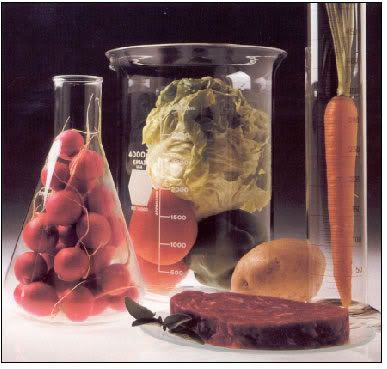Essential Nutrients: Food or Supplements?: Where Should the Emphasis Be?. (PART 1)
THE CONSUMPTION OF adequate nutrients and a proper balance of essential nutrients are critical for maintaining good health. Whether this need is met by happenstance or design, fulfillment has allowed humankind to sustain itself throughout the millennia. During the 20th century, essential nutrients were identified, isolated, and purified. This advance has been a double-edged sword. It has allowed scientists to uncover the mechanisms by which nutrients sustain life and to quickly and inexpensively treat nutritional deficiencies. However, it has also allowed the possibility that the proper balance of purified vitamins and minerals could supplant the need for a varied diet to support life. The nutrition community must determine how best to advise the general public in developed countries with respect to nutrient supplementation in an era in which nutrient deficiencies are rare, chronic disease rates are high, and overweight and obesity have reached epidemic levels. This discussion will not address issues related to well-established nutrient toxicities that have been documented, for example, high doses of vitamins A and D.
Nutrient Requirements
Under agreement with the Institute of Medicine, National Academy of Sciences, the US government has issued dietary guidance via the recommended dietary allowances (RDAs) since 1943. The RDAs were routinely revised according to new scientific information at approximately 5-year intervals until recently, when a new rubric for establishing nutrient recommendations was devised. Under the new system, a series of dietary reference intakes (DRIs) reports have been published. The DRIs for each nutrient include RDAs and estimated average requirements or adequate intakes, along with tolerable upper intake levels. DRIs that have been issued throughout the last decade have made clear that as the amount and scope of scientific evidence accumulates, our estimate of how much and how many nutrients are required to support optimal health and prevent chronic disease has changed. Outstanding issues include whether all essential nutrients have been identified, criteria on which to base requirements, and relative effect one nutrient has on the metabolic requirements of another. These issues have become increasingly important because of the trend toward the unregulated addition of nutrients to a wide range of foods that do not traditionally contain them and the recommendation by some that nutrient supplements be used by the general population.
Single-Nutrient Interventions: Disappointing Results
Strong data show an association between certain dietary patterns; for example, diets high in fruits and vegetables and decreased risk of cardiovascular diseases or diets rich in fruits, vegetables, and low-fat and nonfat dairy products, with or without sodium reduction, and blood pressure. These associations have been attributed to the putative foods being rich sources of nutrients and phytochemicals that can either act independently or in concert. However, instead of focusing on dietary patterns, most intervention trials have used high doses of single nutrients or nutrient cocktails in an attempt to prevent, affect, or mitigate a disease, intermediate measures of assessing disease risk, or disease outcomes. These results for the most part have been disappointing.
Perhaps no better example exists than the disheartening results of the vitamin E intervention trials for the prevention of cardiovascular disease. Epidemiologic observations suggested that the habitual use of vitamin E supplements was associated with decreased risk of developing cardiovascular disease, and some small-scale intervention studies also suggested positive effects. These data were supported biologically. [alpha]-Tocopherol, in particular, was of interest because in vitro addition of vitamin E and other antioxidant nutrients such as beta carotene and vitamin C reduced the susceptibility of isolated low-density lipoprotein (LDL) to oxidation. Moreover, the in vitro data for vitamin E were replicated by feeding high doses of the vitamin to individuals before the isolation of the LDL.
However, as with other examples of positive associations identified from epidemiologic data, subsequent intervention studies did not support the original observations. A series of large, negative intervention studies on vitamin E and/or beta carotene supplements and cardiovascular disease began to emerge. In 2003, after reviewing the data, a joint committee of the American College of Cardiology and American Heart Association (AHA) concluded that “… there is currently no basis for recommending that patients take vitamin C or E supplements or other antioxidants for the express purpose of preventing or treating coronary artery disease.” In 2004, the AHA Nutrition Committee similarly concluded that “At this time, the scientific data do not justify the use of antioxidant vitamin supplements for cardiovascular disease risk reduction.” That same year, an evidence-based review conducted for the US Preventive Services Task Force concluded that “… randomized, controlled trials of specific supplements [to prevent cardiovascular disease] have failed to demonstrate a consistent or significant effect of any single vitamin or combination of vitamins on incidence of or death from cardiovascular disease,” as did another comprehensive and an evidence-based review.
Another example of discordance between the observational associations and a single-nutrient supplement intervention is that of beta carotene, a carotenoid found in deeply colored fruits and vegetables, and lung cancer. A number of retrospective and prospective longitudinal studies had shown that high dietary beta carotene intakes, as well as high blood levels of beta carotene, predicted a lower risk of developing lung cancer, particularly among smokers. Beta carotene was known to be an effective antioxidant and a precursor of vitamin A, thus providing plausible mechanisms. However, a series of beta carotene intervention trials were conducted that categorically dispelled the notion that supplemental beta carotene could effectively reduce lung cancer risk. Results from the Alpha-Tocopherol Beta Carotene Prevention Study and the Carotene and Retinol Efficiency Trial (CARET) showed an increase in lung cancer among smokers or asbestos-exposed workers after beta carotene supplementation. The Physician's Health Study, in which only a small percentage of subjects were smokers (11%), showed no significant effect of beta carotene supplementation on lung cancer. The negative (and harmful) results of 2 beta carotene intervention trials were completely unexpected and counterintuitive, according to predominant thinking of the time. Subsequently, with the ferret as a model, the oxidative breakdown products of beta carotene were found to interfere with retinoid signaling, thereby producing precancerous lesions (squamous metaplasia) in the smoke-exposed animal.
A more recent example is that of folate, homocysteine, and cardiovascular disease. Animal evidence had demonstrated a link between plasma homocysteine levels and cardiovascular disease. Epidemiologic and clinical data suggested that elevated plasma homocysteine levels in humans were associated with increased cardiovascular disease risk. In a review of epidemiologic studies that were conducted in 1999, the authors concluded that “Higher folic acid intake by reducing homocysteine levels promises to prevent arteriosclerotic vascular disease.” However, the relationship between diet and plasma homocysteine is complex and does not rely solely on folate status.
In 1991, a large-scale population intervention trial concluded that folate supplementation resulted in a significant decrease in the risk of children born with neural tube defects. Subsequently, the US Food and Drug Administration mandated that all enriched flour, rice, pasta, cornmeal, and other grain products contain 140 µg of folic acid per 100 g, which resulted in a secular decrease in plasma homocysteine and a rise in folate levels. Concomitant with these changes, anticipation for a potential beneficial role of folate fortification in reducing cardiovascular disease risk was high, but now the enthusiasm has been somewhat tempered as a result of new studies. In the Vitamin Intervention for Stroke Prevention (VISP) study, a cocktail of folic acid, pyridoxine hydrochloride, and cyanocobalamin given to patients who had a nondisabling cerebral infarction successfully lowered homocysteine levels moderately during a 2-year period but had no significant effect on vascular outcomes. Lange et al reported that patients who were recovering from successful coronary stenting procedures and received an intravenous dose followed by oral daily doses of folate, pyridoxine hydrochloride, and cyanocobalamin for 6 months exhibited increased, rather than decreased, risk of in-stent restenosis and the need for target-vessel revascularization. More recently, Morris et al reported that high intakes of folate may be associated with cognitive declines in older persons, presumably because of interference with vitamin B12 metabolism. A final assessment of the relationship between folate and cardiovascular disease and other health outcomes awaits the results of ongoing placebo-controlled intervention trials that take such issues into account as the time-dose relationship relative to disease-progression rates.
These examples suggest that although observational data are valuable in identifying areas in which to conduct intervention studies, they should not be used to draw premature conclusions. Final recommendations for the public must always await confirmation with rigorously controlled intervention trials in humans. These examples provide perspective on the complexity of disease-nutrient relationships and at times the unexpected nature of the science. They should further serve to reinforce the scientific community's need for restraint in making recommendations for nutrient supplementation for chronic disease prevention.
Possible Harmful Effects of Nutrient Supplements on Health Outcomes
The administration of single nutrient supplements in higher-than-physiologic doses can have detrimental effects on disease processes. For example, supplemental folic acid can precipitate vitamin B12 dementia in patients who have minimal vitamin B12 levels but who are without neurologic complaints. Such a case was recently described in a patient who had sickle cell disease and was treated with folate supplementation. This effect of folic acid is not a “masking effect” (that is, folic acid simply masking or hiding vitamin B12 deficiency) but rather an actual precipitation of clinical vitamin B12 deficiency because of the diversion of cobalamin from the central nervous system or from essential biochemical reactions needed for myelin synthesis in favor of the hematopoietic system.
In a similar vein, a recent report has demonstrated a potentially detrimental effect of high-dose antioxidant nutrients on high-density lipoprotein (HDL) cholesterol concentrations in patients treated with statin drugs that inhibit cholesterol biosynthesis. Individuals assigned to a simvastatin-niacin–treated group had a small regression of coronary artery stenosis, whereas those assigned to the simvastatin-niacin plus antioxidant vitamin (vitamins C and E and selenium) – treated group showed progression of the lesions, albeit to a lesser extent than in the placebo-treated group. Additionally, the increase in the concentration of a subfraction of HDL particles associated with decreased disease risk observed in simvastatin-naicin group was attenuated by the antioxidant regimen.
In another case, although supplemental vitamin E may be found to benefit certain segments of the population, such as frail elderly individuals with respect to upper tract respiratory infections, concern has been raised that chronic stimulation of the immune system by vitamin E could raise the incidence of autoimmune diseases. Likewise, theoretically, vitamin E supplements may have detrimental effects in some individuals as assessed by recent in vitro work. Rat hepatocyte secretion of apolipoprotein B-100, a component of very low-density lipoprotein, and LDL was increased when vitamin E was added to the culture medium because of diminished fatty acid peroxidation. Increased apolipoprotein B-100 secretion is a potential mechanism by which supplementation with vitamin E and other antioxidants had unanticipated detrimental effects. A recent meta-analysis of vitamin E intervention studies suggested that vitamin E supplements at doses greater than 400 IU per day increased all-cause mortality. Another example of adverse effects at high levels of supplementation as previously mentioned is that of beta carotene and lung cancer.
Nutrient Toxicity and Foods
Although nutrient toxicity is usually associated with high-dose single-nutrient supplementation, it has been rarely reported from eating naturally occurring nutrient-rich foods. The case of vitamin A is an exception. Vitamin A toxicity was recognized early in arctic explorers after they ate polar bear liver and has been much more recently reported among children from the long-term ingestion of chicken liver. Occasionally, nutrient intoxication has been reported after consumption of fortified foods, primarily in instances when mistakes were made in overfortifying the food product (eg, superabundant amounts of niacin improperly added to pumpernickel bagels and overfortification of milk with vitamin D).
Metabolic Interferences From Nutrient Interactions
The ingestion of large amounts of certain nutrients can interfere with the absorption or metabolism of other nutrients. For example, calcium inhibits heme and nonheme iron absorption. Other nutrient interferences are as follows: iron inhibits zinc absorption, zinc inhibits copper absorption, and vitamin E antagonizes vitamin K action. In humans, vitamin E decreased (nonsignificantly) levels of circulating prothrombin in anticoagulated patients, polyphenols from tea extracts inhibited nonheme iron absorption, and folate interfered with vitamin B12 metabolism. Beta carotene can inhibit lutein absorption when they are given together as supplements, although not when lutein and beta carotene are given together in the form of genetically selected yellow carrots. Finally, supplementing with relatively high doses of [alpha]-tocopherol decreases plasma levels of ‡- and [gamma]-tocopherol.
Not all nutrient interactions are detrimental. Examples of positive effects are that vitamin C can regenerate or spare vitamin E, vitamin E and vitamin C can act synergistically with carotenoids to enhance their individual antioxidant effects, and vitamin C can facilitate nonheme iron absorption. However, this latter effect might not be desirable in subpopulations with polymorphisms for hemochromatosis. Additionally, zinc can be used to block copper absorption in individuals with Wilson disease who are allergic to penicillamine.




0 Comments:
Post a Comment
<< Home